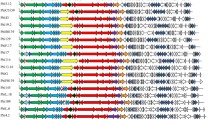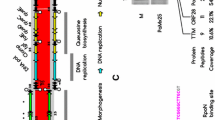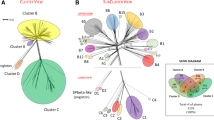Abstract
Comparative phage genomics has become possible due to the availability of more than 100 complete phage genome sequences and the development of powerful bioinformatics tools. This technology, profiting from classical molecular-biology knowledge, has opened avenues of research for topics, which were difficult to address in the past. Now, it is possible to retrace part of the evolutionary history of phage modules by comparative genomics. The diagnosis of relatedness is hereby not uniquely based on sequence similarity alone, but includes topological considerations of genome organization. Detailed transcription maps have allowed in silico predictions of genome organization to be verified and refined. This comparative knowledge is providing the basis for a new taxonomic classification concept for bacteriophages infecting low G+C-content Gram-positive bacteria based on the genetic organization of the structural gene module. An Sfi21-like and an Sfil 1-like genus of Siphoviridae is proposed. The gene maps of many phages show remarkable synteny in their structural genes defining a lambda super-group within Siphoviridae. A hierarchy of relatedness within the lambda super-group suggests elements of vertical evolution in Siphoviridae. Tailed phages are the result of both vertical and horizontal evolution and are thus fascinating objects for the study of molecular evolution. Prophage sequences integrated into the genomes of their bacterial host present theoretical challenges for evolutionary biologists. Prophages represent up to 10% of the genome in some LAB. In pathogenic streptococci prophages confer genes of selective value for the lysogenic cell. The lysogenic conversion genes are located between the lysin gene and the right phage attachment site. Non-attributed genes were found at the same genome position of prophages from lactic streptococci. These genes belong to the few prophage genes transcribed in the lysogen. Prophages from dairy bacteria might therefore also contribute to the evolutionary fitness of non-pathogenic LAB.
Access this chapter
Tax calculation will be finalised at checkout
Purchases are for personal use only
Preview
Unable to display preview. Download preview PDF.
Similar content being viewed by others
References
Altermann E, Klein JR and Henrich B (1999) Primary structure and features of the genome of the Lactobacillus gasseri temperate bacteriophage phi adh. Gene 236: 333–346.
Botstein D (1980) A theory of modular evolution for bacteriophages. Ann. NY Acad. Sci. 354: 484–490.
Braun V, Hertwig S, Neve H, Geis A and Teuber M (1989) Taxonomic differentiation of bacteriophages of Lactococcus lactis by electron microscopy, DNA-DNA hybridization, and protein profiles. J. Gen. Microbiol. 135: 2551–2560.
Brondsted L, Ostergaard S, Pedersen M, Hammer K and Vogensen FK (2001) Analysis of the complete DNA sequence of the temperate bacteriophage TP901–1: evolution, structure, and gen-
ome organization of lactococcal bacteriophages. Virology 283: 93–109.
Bruttin A, Desiere F, Lucchini S, Foley S and Brüssow H (1997) Characterization of the lysogeny DNA module from the temperate Streptococcus thermophilus bacteriophage Sfi21. Virology 233: 136–148.
Brüssow H (2001) Phages of dairy bacteria. Annu. Rev. Microbiol. 55: 283–303.
Brüssow H and Desiere F (200la) Comparative phage genomics and the evolution of Siphoviridae: insights from dairy phages. Mol. Microbiol. 39: 213–223.
Brüssow H and Desiere F (2001b) Comparative phage genomics and the evolution of Siphoviridae: insights from dairy phages. Mol. Microbiol. 39: 213–222.
Brüssow H and Hendrix R (2002) Phage genomics: Small is beautiful. Cell 108: 13–16. Brüssow H, Fremont M, Bruttin A, Sidoti J, Constable A and Fryder V (1994) Detection and classification of Streptococcus thermophilus bacteriophages isolated from industrial milk fermentation. Appl. Environ. Microbiol. 60: 4537–4543.
Casjens S, Hatfull GF and Hendrix R (1992) Evolution of dsDNA tailed-bacteriophage genomes. Sem. Virol. 3: 383–397.
Chandry PS, Moore SC, Boyce JD, Davidson BE and Hillier AJ (1997) Analysis of the DNA sequence, gene expression, origin of replication and modular structure of the Lactococcus lactis lytic bacteriophage skl. Mol. Microbiol. 26: 49–64.
Chopin A, Bolotin A, Sorokin A, Ehrlich SD and Chopin M (2001) Analysis of six prophages in Lactococcus lactis IL 1403: different genetic structure of temperate and virulent phage populations. Nucleic Acids Res. 29: 644–651.
Desiere F, Lucchini S, Bruttin A, Zwahlen MC and Brüssow H (1997) A highly conserved DNA replication module from Streptococcus thermophilus phages is similar in sequence and topology to a module from Lactococcus lactis phages. Virology 234: 372–382.
Desiere F, Lucchini S and Brüssow H (1998) Evolution of Streptococcus thermophilus bacteriophage genomes by modular exchanges followed by point mutations and small deletions and insertions. Virology 241: 345–356.
Desiere F, Pridmore RD and Brüssow H (2000) Comparative genomics of the late gene cluster from lactobacillus phages. Virology 275: 294–305.
Desiere F, Mahanivong C, Hillier A J, Chandry PS, Davidson BE and Brüssow H (2001) Comparative genomics of lactococcal phages: insight from the complete genome sequence of Lactococcus lactis phage BK5-T. Virology 283: 240–252.
Desiere F, McShan WM, van Sinderen D, Ferretti JJ and Brüssow H (2001b) Comparative genomics reveals close genetic relationships between phages from dairy bacteria and pathogenic streptococci: Evolutionary implications for prophage-host interactions. Virology 288: 325–341.
Duplessis M and Moineau S (2001) Identification of a genetic determinant responsible for host specificity in Streptococcus thermophilus bacteriophages. Mol. Microbiol. 41: 325–336.
Eppler K, Wyckoff E, Goates J, Parr R and Casjens S (1991) Nucleotide sequence of the bacteriophage P22 genes required for DNA packaging. Virology 183: 519–538.
Ferretti JJ, McShan WM, Ajdic D, Savic DJ, Savic G, Lyon K, Primeaux C, Sezate S, Suvorov AN, Kenton S, Lai HS, Lin SP, Qian Y, lia HG, Najar FZ, Ren Q, Zhu H, Song L, White J, Yuan X, Clifton SW, Roe BA and McLaughlin R (2001) Complete genome sequence of an M1 strain of Streptococcus pyogenes. Proc. Natl. Acad. Sci. U.S.A. 98: 4658–4663.
Foley S, Lucchini S, Zwahlen MC and Briissow H (1998) A short noncoding viral DNA element showing characteristics of a replication origin confers bacteriophage resistance to Streptococcus thermophilus. Virology 250: 377–387.
Goshorn SC and Schlievert PM (1989) Bacteriophage association of streptococcal pyrogenic exotoxin type C. J. Bacteriol. 171: 3068–3073.
Harrington DJ, Sutcliffe IC, Chanter N (2002) The molecular basis of Streptococcus equi infection and disease. Microbes Infect. 4 (4): 501–105.
Hendrix RW, Smith MC, Burns RN, Ford ME and Hatfull GF (1999) Evolutionary relationships among diverse bacteriophages and prophages: all the world’s a phage. Proc. Natl. Acad. Sci. U.S.A. 96: 2192–2197.
Hynes WL and Ferretti JJ (1989) Sequence analysis and expression in Escherichia coli of the hyaluronidase gene of Streptococcus pyogenes bacteriophage H4489A. Infect.Immun. 57: 533–539.
Hynes WL, Hancock L and Ferretti J J (1995) Analysis of a second bacteriophage hyaluronidase gene from Streptococcus pyogenes: evidence for a third hyaluronidase involved in extracellular enzymatic activity. Infect. Immun. 63: 3015–3020.
Inagaki Y, Myouga F, Kawabata H, Yamai S and Watanabe H (2000) Genomic differences in Streptococcus pyogenes serotype M3 between recent isolates associated with toxic shock-like syndrome and past clinical isolates. J. Infect. Dis. 181: 975–983.
Jarvis AW, Fitzgerald GF, Mata M, Mercenier A, Neve H, Powell IB, Ronda C, Saxelin M and Teuber M (1991) Species and type phages of lactococcal bacteriophages. Intervirology 32: 2–9.
Jarvis AW, Lubbers MW, Beresford TP, Ward U, Waterfield NR, Collins U and Jarvis BD (1995) Molecular biology of lactococcal bacteriophage c2. Dev. Biol. Stand. 85: 561–567.
Kodaira KI, Oki M, Kakikawa M, Watanabe N, Hirakawa M, Yamada K and Taketo A (1997) Genome structure of the Lactobacillus temperate phage phi gle: the whole genome sequence and the putative promoter/repressor system. Gene 187: 45–53.
Koonin EV, Aravind L and Kondrashov AS (2000) The impact of comparative genomics on our understanding of evolution. Cell 101: 573–576.
Lawrence JG, Hendrix R and Casjens S (2001) Where are the pseudogenes in bacterial genomes? Trends Microbiol. 9 (11): 535–540.
Lazarevic V, Dusterhoft A, Soldo B, Hilbert H, Mauel C and Kara-mata D (1999) Nucleotide sequence of the Bacillus subtilis temperate bacteriophage SPbetac2. Microbiology 145 (Pt 5): 1055–1067.
Le Marrec C, van Sinderen D, Walsh L, Stanley E, Vlegels E, Moineau S, Heinze P, Fitzgerald G and Fayard B (1997) Two groups of bacteriophages infecting Streptococcus thermophilus can be distinguished on the basis of mode of packaging and genetic determinants for major structural proteins. Appl. Environ. Microbiol. 63: 3246–3253.
Loessner MJ, Inman RB, Lauer P and Calendar R (2000) Complete nucleotide sequence, molecular analysis and genome structure of bacteriophage A118 of Listeria monocytogenes: implications for phage evolution. Mol. Microbiol. 35: 324–340.
Lubbers MW, Waterfield NR, Beresford TP, Le PR and Jarvis AW (1995) Sequencing and analysis of the prolate-headed lactococcal bacteriophage c2 genome and identification of the structural genes. Appl. Environ. Microbiol. 61: 4348–4356.
Lucchini S, Desiere F and Brüssow H (1998) The structural gene module in Streptococcus thermophilus bacteriophage phi Sfill shows a hierarchy of relatedness to Siphoviridae from a wide range of bacterial hosts. Virology 246: 63–73.
Lucchini S, Desiere F and Brüssow H (1999a) Comparative genomics of Streptococcus thermophilus phage species supports a modular evolution theory. J. Virol. 73: 8647–8656.
Lucchini S, Desiere F and Brüssow H (1999b) Similarly organized lysogeny modules in temperate Siphoviridae from low GC content Gram-positive bacteria. Virology 263: 427–435.
Lucchini S, Desiere F and Brüssow H (1999c) The genetic relationship between virulent and temperate Streptococcus thermophilus bacteriophages: Whole genome comparison of cos-site phages Sfi19 and Sfi21. Virology 260: 232–243.
Madsen PL and Hammer K (1998) Temporal transcription of the lactococcal temperate phage TP901–1 and DNA sequence of the early promoter region. Microbiology 144: 2203–2215.
Mahanivong C, Boyce JD, Davidson BE and Hillier AJ (2001) Sequence analysis and molecular characterization of the Lactococcus lactis temperate bacteriophage BK5-T. Appl Environ Microbiol. 67: 3564–3576.
Marciel AM, Kapur V and Musser JM (1997) Molecular population genetic analysis of a Streptococcus pyogenes bacteriophageencoded hyaluronidase gene: recombination contributes to allelic variation. Microb. Pathog. 22: 209–217.
Martin AC, Lopez R and Garcia P (1996) Analysis of the complete nucleotide sequence and functional organization of the genome of Streptococcus pneumoniae bacteriophage Cp- 1. J. Virol. 70: 3678–3687.
McShan WM, Tang YF and Ferretti JJ (1997) Bacteriophage T12 of Streptococcus pyogenes integrates into the gene encoding a serine tRNA. Mol. Microbiol. 23: 719–728.
Mikkonen M, Dupont L, Alatossava T and Ritzenthaler P (1996) Defective site-specific integration elements are present in the genome of virulent bacteriophage LL-H of Lactobacillus delbrueckii. Appl. Environ. Microbiol. 62: 1847–1851.
Mikkonen M, Raisanen L and Alatossava T (1996) The early gene region completes the nucleotide sequence of Lactobacillus delbrueckii subsp. lactis phage LL-H. Gene 175: 49–57.
Moscoso M and Suarez JE (2000) Characterization of the DNA replication module of bacteriophage A2 and use of its origin of replication as a defense against infection during milk fermentation by Lactobacillus casei. Virology 273: 101–111.
Nelson D, Loomis L and Fischetti VA (2001) Prevention and elimination of upper respiratory colonization of mice by group A streptococci by using a bacteriophage lytic enzyme. Proc. Natl. Acad. Sci. U.S.A. 98: 4107–4112.
Neve H, Zenz KI, Desiere F, Koch A, Heller KJ and Brüssow H (1998) Comparison of the lysogeny modules from the temperate Streptococcus thermophilus bacteriophages TP-J34 and Sfi21: Implications for the modular theory of phage evolution. Virology 241: 61–72.
Nida SK and Ferretti JJ (1982) Phage influence on the synthesis of extracellular toxins in group A streptococci. Infect. Immun. 36: 745–750.
Prevots F, Mata M and Ritzenthaler P (1990) Taxonomic differentiation of 101 lactococcal bacteriophages and characterization of bacteriophages with unusually large genomes. Appl. Environ. Microbiol. 56: 2180–2185.
Schouler C, Ehrlich SD and Chopin MC (1994) Sequence and organization of the lactococcal prolate-headed bIL67 phage genome. Microbiology. 140: 3061–3069.
Smoot LM, Smoot JC, Graham MR, Somerville GA, Sturdevant DE, Migliaccio CA, Sylva GL and Musser JM (2001) Global differential gene expression in response to growth temperature alteration in group A Streptococcus. Proc. Natl. Acad. Sci. U.S.A. 98: 10416–10421.
Smoot JC, Barbian KD, Van Gompel JJ, Smoot LM, Chaussee MS, Sylva GL, Sturdevant DE, Ricklefs SM, Porcella SF, Parkins LD, Beres SB, Campbell DS, Smith TM, Zhang Q, Kapur V, Daly JA, Veasy LG and Musser JM (2002) Genome sequence and comparative microarray analysis of serotype M18 group A Streptococcus strains associated with acute rheumatic fever outbreaks. Proc. Natl. Acad. Sci. U.S.A. 99: 4668–4673.
Sonnhammer E L and Durbin R (1995) A dot-matrix program with dynamic threshold control suited for genomic DNA and protein sequence analysis. Gene 167: GC1–10.
Stanley, E., Fitzgerald, G. F., Le Marrec, C., Fayard, B., and van Sinderen, D. (1997). Sequence analysis and characterization of phi 01205, a temperate bacteriophage infecting Streptococcus thermophilus CNRZ1205. Microbiology. 143: 3417–3429.
Stanley E, Walsh L, van der ZA, Fitzgerald GF and van Sinderen D (2000) Identification of four loci isolated from two Streptococcus thermophilus phage genomes responsible for mediating bacteriophage resistance. FEMS Microbiol. Lett. 182: 271–277.
Tremblay DM and Moineau S (1999) Complete genomic sequence of the lytic bacteriophage DTl of Streptococcus thermophilus. Virology 255: 63–76.
van Sinderen D, Karsens H, Kok J, Terpstra P, Ruiters MH, Venema G and Nauta A (1996) Sequence analysis and molecular characterization of the temperate lactococcal bacteriophage r1t. Mol. Microbiol. 19: 1343–1355.
Vasala A, Dupont L, Baumann M, Ritzenthaler P and Alatossava T (1993) Molecular comparison of the structural proteins encoding gene clusters of two related Lactobacillus delbrueckii bacteriophages. J. Virol. 67: 3061–3068.
Ventura M, Bruttin A, Canchaya C and Brüssow H (2002) Transcription analysis of Streptococcus thermophilus phages in the lysogenic state. ( 2002 ) Virology. ( In Press ).
Weeks CR and Ferretti JJ (1984) The gene for type A streptococcal exotoxin (erythrogenic toxin) is located in bacteriophage T12. Infect. Immun. 46: 531–536.
Whiteley M, Bangera MG, Bumgaraer RE, Parsek MR, Teitzel GM, Lory S and Greenberg EP (2001) Gene expression in Pseudomonas aeruginosa biofilms. Nature 413: 860–864.
Yu CE and Ferretti JJ (1991) Molecular characterization of new group A streptococcal bacteriophages containing the gene for streptococcal erythrogenic toxin A (speA). Mol. Gen. Genet. 231: 161–168.
Author information
Authors and Affiliations
Editor information
Editors and Affiliations
Rights and permissions
Copyright information
© 2002 Springer Science+Business Media Dordrecht
About this chapter
Cite this chapter
Desiere, F., Lucchini, S., Canchaya, C., Ventura, M., Brüssow, H. (2002). Comparative genomics of phages and prophages in lactic acid bacteria. In: Siezen, R.J., Kok, J., Abee, T., Schasfsma, G. (eds) Lactic Acid Bacteria: Genetics, Metabolism and Applications. Springer, Dordrecht. https://doi.org/10.1007/978-94-017-2029-8_5
Download citation
DOI: https://doi.org/10.1007/978-94-017-2029-8_5
Publisher Name: Springer, Dordrecht
Print ISBN: 978-90-481-6141-6
Online ISBN: 978-94-017-2029-8
eBook Packages: Springer Book Archive




